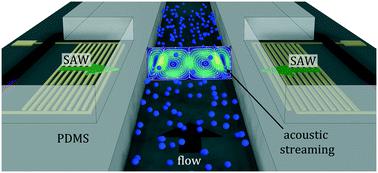Our official English website, www.x-mol.net, welcomes your feedback! (Note: you will need to create a separate account there.)
On the acoustically induced fluid flow in particle separation systems employing standing surface acoustic waves – Part I
Lab on a Chip ( IF 6.1 ) Pub Date : 2022-04-28 , DOI: 10.1039/d1lc01113h Sebastian Sachs 1 , Mostafa Baloochi 2 , Christian Cierpka 1, 2 , Jörg König 1
Lab on a Chip ( IF 6.1 ) Pub Date : 2022-04-28 , DOI: 10.1039/d1lc01113h Sebastian Sachs 1 , Mostafa Baloochi 2 , Christian Cierpka 1, 2 , Jörg König 1
Affiliation

|
By integrating surface acoustic waves (SAW) into microfluidic devices, microparticle systems can be fractionated precisely in flexible and easily scalable Lab-on-a-Chip platforms. The widely adopted driving mechanism behind this principle is the acoustic radiation force, which depends on the size and acoustic properties of the suspended particles. Superimposed fluid motion caused by the acoustic streaming effect can further manipulate particle trajectories and might have a negative influence on the fractionation result. A characterization of the crucial parameters that affect the pattern and scaling of the acoustically induced flow is thus essential for the design of acoustofluidic separation systems. For the first time, the fluid flow induced by pseudo-standing acoustic wave fields with a wavelength much smaller than the width of the confined microchannel is experimentally revealed in detail, using quantitative three-dimensional measurements of all three velocity components (3D3C). In Part I of this study, we focus on the fluid flow close to the center of the surface acoustic wave field, while in Part II the outer regions with strong acoustic gradients are investigated. By systematic variations of the SAW-wavelength λSAW and channel height H, a transition from vortex pairs extending over the entire channel width W to periodic flows resembling the pseudo-standing wave field is revealed. An adaptation of the electrical power, however, only affects the velocity scaling. Based on the experimental data, a validated numerical model was developed in which critical material parameters and boundary conditions were systematically adjusted. Considering a Navier slip length at the substrate-fluid interface, the simulations provide a strong agreement with the measured velocity data over a large frequency range and enable an energetic consideration of the first and second-order fields. Based on the results of this study, critical parameters were identified for the particle size as well as for channel height and width. Progress for the research on SAW-based separation systems is obtained not only by these findings but also by providing all experimental velocity data to allow for further developments on other sites.
中文翻译:

关于采用驻表面声波的粒子分离系统中的声学诱导流体流动——第一部分
通过将表面声波 (SAW) 集成到微流控设备中,微粒系统可以在灵活且易于扩展的芯片实验室平台中精确分离。该原理背后广泛采用的驱动机制是声辐射力,它取决于悬浮粒子的大小和声学特性。由声流效应引起的叠加流体运动可以进一步操纵粒子轨迹,并可能对分馏结果产生负面影响。因此,影响声诱导流动的模式和比例的关键参数的表征对于声流体分离系统的设计至关重要。首次,使用所有三个速度分量的定量三维测量(3D3C),通过实验详细揭示了由波长远小于受限微通道宽度的伪驻声波场引起的流体流动。在本研究的第一部分中,我们关注靠近表面声波场中心的流体流动,而在第二部分中,研究了具有强声学梯度的外部区域。通过 SAW 波长的系统变化λ SAW和通道高度H,从涡旋对延伸到整个通道宽度W的过渡揭示了类似于伪驻波场的周期性流动。然而,电功率的适配仅影响速度缩放。基于实验数据,开发了一个经过验证的数值模型,其中系统地调整了关键材料参数和边界条件。考虑到基板-流体界面处的 Navier 滑移长度,该模拟与在大频率范围内测量的速度数据具有很强的一致性,并能够对一阶和二阶场进行能量考虑。根据这项研究的结果,确定了粒径以及通道高度和宽度的关键参数。
更新日期:2022-04-28
中文翻译:

关于采用驻表面声波的粒子分离系统中的声学诱导流体流动——第一部分
通过将表面声波 (SAW) 集成到微流控设备中,微粒系统可以在灵活且易于扩展的芯片实验室平台中精确分离。该原理背后广泛采用的驱动机制是声辐射力,它取决于悬浮粒子的大小和声学特性。由声流效应引起的叠加流体运动可以进一步操纵粒子轨迹,并可能对分馏结果产生负面影响。因此,影响声诱导流动的模式和比例的关键参数的表征对于声流体分离系统的设计至关重要。首次,使用所有三个速度分量的定量三维测量(3D3C),通过实验详细揭示了由波长远小于受限微通道宽度的伪驻声波场引起的流体流动。在本研究的第一部分中,我们关注靠近表面声波场中心的流体流动,而在第二部分中,研究了具有强声学梯度的外部区域。通过 SAW 波长的系统变化λ SAW和通道高度H,从涡旋对延伸到整个通道宽度W的过渡揭示了类似于伪驻波场的周期性流动。然而,电功率的适配仅影响速度缩放。基于实验数据,开发了一个经过验证的数值模型,其中系统地调整了关键材料参数和边界条件。考虑到基板-流体界面处的 Navier 滑移长度,该模拟与在大频率范围内测量的速度数据具有很强的一致性,并能够对一阶和二阶场进行能量考虑。根据这项研究的结果,确定了粒径以及通道高度和宽度的关键参数。



























 京公网安备 11010802027423号
京公网安备 11010802027423号